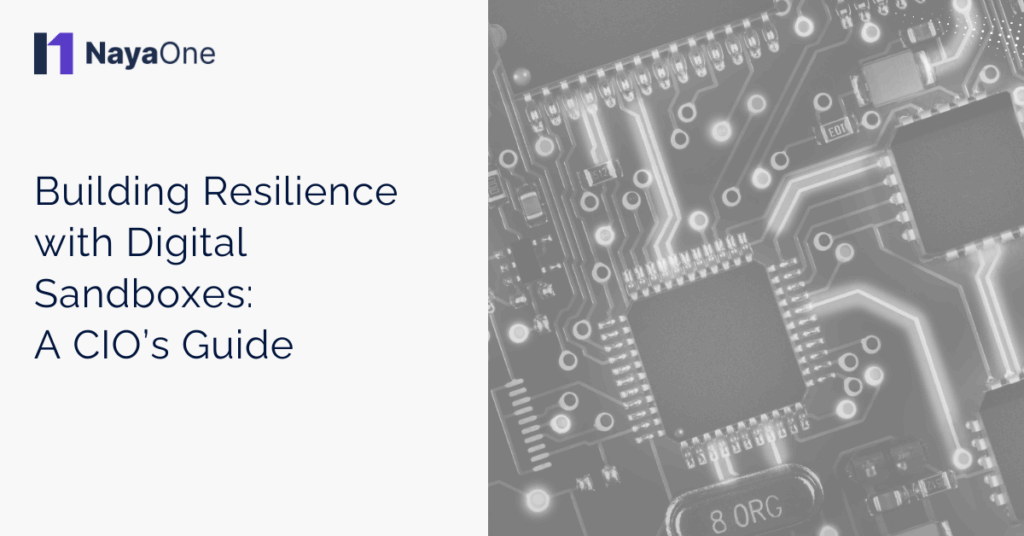Why Innovation Trips Over Itself
Enterprises today are pressured from all sides: legacy systems, regulatory demands, tight budgets, and rising competition. Digital transformation is no longer optional - yet many innovation efforts stall before they begin.
A recurring pain point? Vendor onboarding, evaluation, and technology trial cycles are slow, opaque, and risky. Too many Proofs-of-Concept (PoCs) never make it to production because there’s no safe, repeatable way to validate new solutions. Organisations spend months (or even more than a year) building integrations, opening access, managing security, and handling compliance - only to abandon or rework the effort.
Digital sandboxes offer a better way. They embed safety, infrastructure guardrails, visibility, and standardisation into the evaluation process so innovation can move forward - without exposing critical systems or data.
This guide explores how CIOs and CTOs should think about digital sandboxes as part of their infrastructure. You’ll get patterns, decision criteria, and an architectural lens.
What Is a Digital Sandbox, Really?
Definition: A digital sandbox is a controlled, isolated environment in which enterprises can evaluate external technologies, services, or vendors (e.g. AI, fraud detection, analytics platforms) without exposing production systems or sensitive data. It includes governance, monitoring, and synthetic or emulated datasets to allow realistic testing.
Core building blocks include:
- Access & Network Isolation: The sandbox is air-gapped or gated so connectivity is safe and tightly controlled.
- Synthetic / Masked Data: Realistic but non-sensitive data that preserves shape, distribution, schema, and edge cases.
- Governance & Audit: Policy enforcement, logging, usage tracing, and access controls.
- Provisioned Environments & Templates: Pre-configured stacks or blueprints so new vendor trials can spin up quickly.
- Comparative Testing / Vendor Parallelism: Ability to run multiple vendor PoCs side-by-side under the same conditions.
- Integration Pathways: Clear mechanisms to promote validated services into production pipelines or environments safely.
Why CIOs Should Care (Beyond Hype)
Digital sandboxes aren’t just a cool experiment. They address real enterprise constraints, especially in regulated industries like financial services.
A. Compress Onboarding & Proof-of-Concept Cycles
Time lost in integration, security reviews, or data access procedures often dominates the effort. With pre-configured sandbox environments, vendors can be trialed in weeks instead of months.
B. Lower Vendor Risk & Improve Vendor Decisions
Today, many vendors fail the late-stage trials. The cost of mis-choosing a vendor late in the lifecycle (rework, security gaps, compliance misses) can be substantial. A sandbox gives you early, evidence-based elimination or validation.
C. Ensure Compliance & Auditability
Every vendor must meet internal and regulatory standards (data sovereignty, encryption, access privileges). A sandbox gives you automated logging, policy enforcement, and a traceable testing path - so you can show regulators that vendor validation was systematic.
D. Foster Innovation Within a Controlled Framework
Business units want rapid experimentation. The sandbox makes it safe. It creates an institutional path: ideas go from PoC → validation → integration without chaotic shadow IT.
E. Architect for Resilience
By decoupling experimentation from production, you reduce risk of downtime, data corruption, or cascading system failures.
Architecture Patterns & Decision Frameworks
Pattern A: Single Sandbox Gateway
One shared sandbox layer through which all vendors or new technologies pass. This central gateway controls access, monitoring, and stays consistent across use cases.
Pros:
Strong standardisation
Easier governance
Central visibility
Cons:
Might become bottleneck if under-resourced
Need capacity planning
Pattern B: Domain-Specific Sandboxes
Separate sandboxes per domain (e.g. fraud, AI, payments). Each has domain-specific templates, controls, and datasets.
Pros:
More tailored environments
Better performance / isolation per domain
Cons:
More operational overhead
Potential divergence in control standards
Use Cases in Financial Services
| Use Case | Pain Point | Sandbox Role |
|---|---|---|
| AI / ML vendor evaluation | Model drift, data quality, security | Run model test cycles on synthetic data |
| Fraud detection | Sensitive transaction data, real-time constraints | Simulate transaction streams and test vendor logic |
| Payments / Fintech APIs | Integration risk and downtime | Validate connectivity, error paths, latency |
| Compliance tooling | Data leaks, regulatory alignment | Stress test policy enforcement, access boundaries |
| Analytics & BI platforms | Data movement, schema compatibility | Evaluate ETL performance, aggregation logic |
How NayaOne Delivers a Production-Grade Sandbox
While enterprises often debate between a single sandbox gateway (Pattern A) and domain-specific sandboxes (Pattern B), the NayaOne sandbox combines the strengths of both. It acts as a centralised gateway where all vendors and technologies connect, with standardised governance, monitoring, and compliance built in.
Inside that gateway, NayaOne provides domain-specific templates and synthetic data libraries - for AI, payments, fraud, claims, and more - ensuring tests are realistic and relevant without the overhead of running multiple siloed sandboxes.
This hybrid approach gives enterprises the control and auditability of a single gateway, alongside the specialisation of domain-specific sandboxes. The result: reduced complexity, lower costs, and faster vendor validation.
At NayaOne, our architecture brings this to life through:
- Unified Gateway Marketplace: Each vendor connects through a secure, governed gateway
- Prebuilt Templates & Blueprints: Domain-specific stacks ready for AI, fraud, analytics testing
- Synthetic Data Engine: Generate datasets with realistic distributions, edge patterns, anomalies
- Audit & Monitoring Suite: Centralised logs, usage dashboards, anomaly alerts
- Parallel PoC Infrastructure: Run vendor trials side-by-side under identical conditions
- Handover Pipelines: Clear paths to promote validated services into staging or production safely
We’ve seen clients reduce vendor evaluation cycles from months to weeks, eliminate late-stage integration failures, and get better governance confidence when engaging third parties.
The Future of Innovation Infrastructure
Digital sandboxes are evolving from “nice to have” to essential infrastructure - akin to API gateways, identity platforms, or internal developer portals. For modern enterprises, especially in regulated industries, they are the mechanism by which innovation becomes safe, repeatable, and governed.
For CIOs, CTOs, and infrastructure leaders: don’t treat the sandbox as a side experiment. Build it as a foundational component of your delivery architecture. Start small, standardise, then scale.
With the right architecture, governance, and tooling, your organisation can turn vendor risk into vendor opportunity - and deliver innovation at pace, safely.





